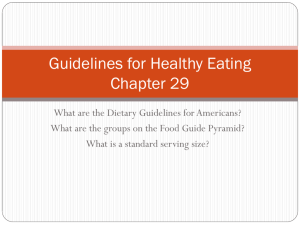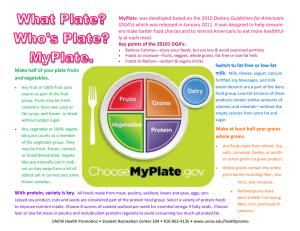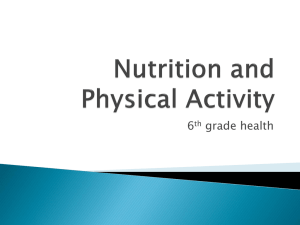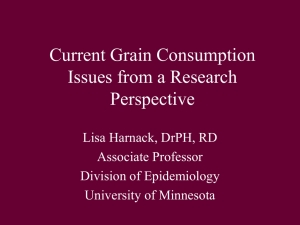Dietary Guidelines 2010 7 Grade th
advertisement
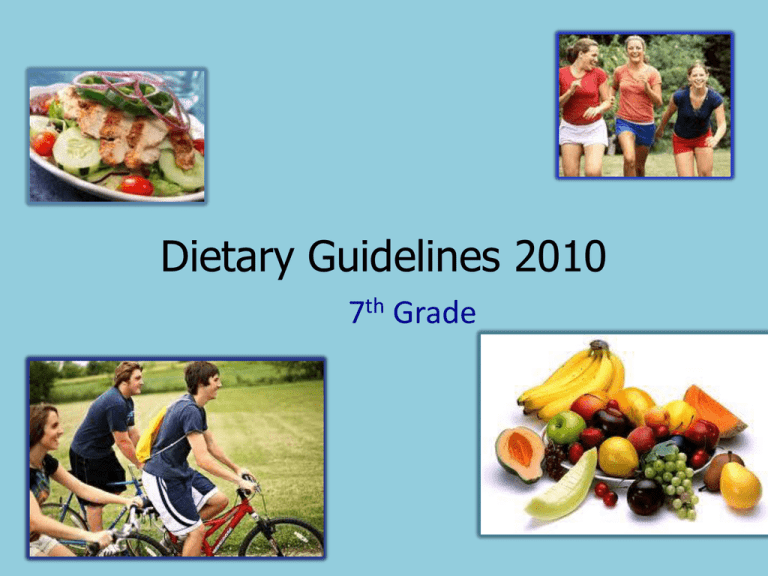
Dietary Guidelines 2010 7th Grade Portion Size Comparison • 1 pancake • ½ cup of grapes • 2 tablespoons of peanut butter • 1 serving of chicken • ½ cup of fruit • 1 serving of butter • • • • • • 1 cup of green salad ½ cup of rice ½ cup broccoli 1 ½ ounces of cheese 1 cup of pasta 1 glass of milk What is a "Healthy Diet"? The Dietary Guidelines describe a healthy diet as one that: • Emphasizes fruits, vegetables, whole grains, and fat-free or low-fat milk and milk products • Includes lean meats, poultry, fish, beans, eggs, and nuts • Is low in saturated fats, trans fats, cholesterol, salt (sodium), and added sugars Caloric Balance The balance between calories consumed in foods and beverages and calories expended through physical activity and metabolic processes. Nutrient Density Nutrient-dense foods and beverages provide vitamins, minerals, and other substances that may have positive health effects with relatively few calories. All vegetables, fruits, whole grains, seafood, eggs, beans and peas, unsalted nuts and seeds, fat-free and low-fat milk and milk products, and lean meats and poultry (when prepared without adding solid fats or sugars) are nutrientdense foods. Balancing Calories to Manage Weight http://www.choosemyplate.gov/guidelines/index.html Foods and Food Components to Reduce http://www.choosemyplate.gov/guidelines/index.html Foods and Food Components to Reduce Foods and Nutrients to Increase http://www.choosemyplate.gov/guidelines/index.html Foods and Food Components to Reduce Eat this Use this Not that Not that Building Healthy Eating Patterns Key Recommendations: • Select an eating pattern that meets nutrient needs over time at an appropriate calorie level. • Account for all foods and beverages consumed and assess how they fit within a total healthy eating pattern. • Follow food safety recommendations when preparing and eating foods to reduce the risk of foodborne illnesses. Specific Recommendations • Limit calorie intake to the amount needed to attain or maintain a healthy weight for adults, and for appropriate weight gain in children and adolescents. • Consume foods from all food groups in nutrientdense forms and in recommended amounts. • Reduce intake of solid fats (major sources of saturated and trans fatty acids). Specific Recommendations • Replace solid fats with oils (major sources of polyunsaturated and monounsaturated fatty acids) when possible. • Reduce intake of added sugars. Specific Recommendations • Reduce intake of refined grains and replace some refined grains with whole grains. • Reduce intake of sodium (major component of salt). Specific Recommendations • Increase intake of vegetables and fruits. • Increase intake of whole grains. • Increase seafood intake by replacing some meat or poultry with seafood. Specific Recommendations Increase intake of milk and milk products and replace whole milk and full-fat milk products with fat-free or low-fat choices to reduce solid fat intake.
